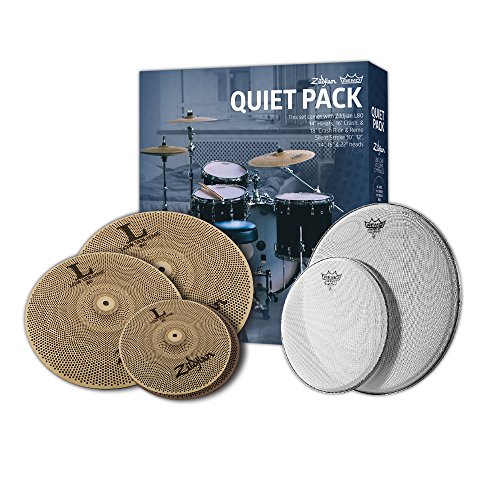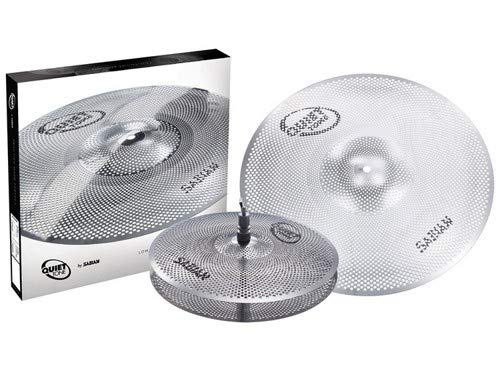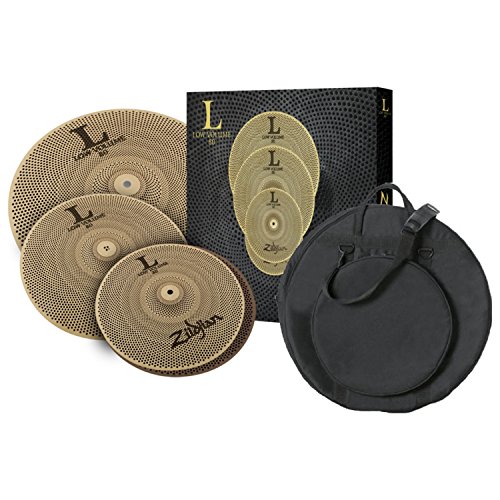This week, for the sake of mastering our skills at neighbor-friendly and non-damaging levels, we have researched some of the best low volume cymbals on the market to find a practice set that won't leave a ringing in your ears.
There are some very commendable sets which make for a sensible addition to your kit when you are not in the limelight. They give your ears a rest between gigs but still provide an authentic live playing experience.
We have also written a thorough buyers guide to give you an in-depth understanding of their benefits. But first, let's look at our selections.
At a glance: Our top 3 picks

Zildjian L80 Low Volume Quiet Cymbals

- High-quality manufacturing.
- 70-80% reduction.
- Cymbals and heads provided.

Sabian QTPC501 Quiet Tone Practice Cymbal

- High-quality manufacturing.
- 70-80% reduction.
- Cymbals and heads provided.

Zildjian LV348 LOW VOLUME

- High-quality manufacturing.
- 70-80% reduction.
- Cymbals and heads provided.
View The Best Low Volume Cymbals Below
1. Zildjian L80 Low Volume Quiet Cymbals
We're getting the ball rolling with the full-package. Zildjian L80 not only provides a pair of hi-hats, crash, and crash-ride, but also throws in a complete set of Remo heads to lower the volume of your entire kit.
These cymbals are impeccably manufactured, utilizing Zildjian's proprietary techniques; a clever alloy combination reduces the volume of typical cymbals by 70-80%, making a big difference.
The hi-hats measure 14", the crash is 16". The crash-ride is 18" in diameter. They have the familiar bells and match the company's traditional specs in every way. That is, aside from their composition, which provides the necessary dampening and reduction you need.
They have an acoustic tone and allow for an authentic play. They also have a nice matte finish.
They come with silent stroke mesh drum-heads (10",12",14"16" and 22") by Remo, providing a good surface that doesn't impede the playability.
Pros:
+ High-quality manufacturing.
+ 70-80% reduction.
+ Cymbals and heads provided.
Why We Liked It - They are exceptionally made. They feel like genuine, full-volume cymbals. You can play the heads strongly, unlike others.
2. Sabian QTPC501 Quiet Tone Practice Cymbal
Our second selection is a Sabian set from the Quiet Tone practice series. They aren't quite as extensive as our opening option, but they are cheaper.
You get an 18" crash-ride with a pair of 13" hi-hats. Although they are slightly smaller, they still provide an adequate surface area to perfect your rhythm and fine-motor coordination.
They are all well-constructed from a durable, dent-resistant alloy, and they feature close-knit perforations which disrupt the sound-waves quelling the sustain to reduce the volume effectively.
Their pronounced bells imitate the genuine article, so your techniques can progress without an unnatural response.
Pros:
+ Perforated cymbals.
+ Natural feel.
+ Durable alloy composition.
Why We Liked It - They are a lower-cost solution which are, again, well-made. They are realistic to play and very quiet.
3. Zildjian LV348 LOW VOLUME
We're back to Zildjian for the cymbal side of the full-package we opened with. This is a great product for those of you who have head-dampeners or are solely searching for a cymbal solution.
We will keep this review brief, as they are the same L80 models with the same dimensions, including 13" (hi-hat pair),14" (crash) and 18" (crash-ride).
These are a premium quality set, manufactured to a high degree of quality control that provides some of the best decibel reduction levels possible (around 70-80%).
The crash is silent when compared side by side to your typical Zildjian, but provides the tactile sensitivity you need to practice properly.
The proprietary alloy blend employed within the fabrication, with its lighter weight and the indentation, is what stifles the sustain.
They are manufactured to match the traditional sets to a T; this gives them a natural, realistic feel, which really only differs in volume and tonality.
Pros:
+ Huge decibel reduction.
+ Superior build quality.
+ Natural feel.
Why We Liked It - The workmanship is phenomenal. They are a stand-out set as far as volume reduction goes. They don't have an offensive, tinny tone either, which can often be the case with low volume cymbals.
4. UFO Low Volume Cymbals
VIEW PRICE
The last item we are looking at is this solitary crash-ride cymbal from UFO which, again, matches traditional specs in terms of its dimension and playability.
It's a lightweight option, which is, again, formed from a less-dense, less-acoustic alloy blend.
It's fabricated with tiny indentations, which helps to naturally deaden the vibrations, preventing sustained ringing and muffling the projection.
It measures 14 inches in diameter, which gives you a large surface area to strike. It has a profound bell, which is another reason why it makes for a great choice. The sound is notably quieter than a traditional crash-ride, rendering it perfect for practice.
Pros:
+ Single cymbal option.
+ Great quality construction.
+ Naturally dampening design.
Why We Liked It - It provides a perfect solution for a quiet practice. The low-weight, indented design and materials render it unable to ring-out. The shape keeps it realistic to play. The tone isn't cheap-sounding and it's affordably priced to boot.
Low Volume Cymbals Buyers Guide
Why Purchase Low Volume Cymbals?
Well, the glaringly-obvious answer is to be able to practice at lower volumes. The drum-kit is, unfortunately, considered one of the loudest instruments to learn.
For a budding drummer, a basement or garage becomes standard as far as practice locations are concerned, unless you live in an isolated area or have sound-proofing in place.
Needing quieter cymbals, however, extends beyond upsetting those around you. More importantly, a drum-kit can be damaging to your ears. Many of us are actually guilty of brushing this off in the early days, especially if we're embracing a rock-and-roll lifestyle, but it's important to consider our ear safety.
Ear Damage
Our ears are an important tool as a musician, regardless of what instrument we play. Being exposed to frequencies in close proximity at dangerous decibel levels can be dangerous.
Our ears are filled with cilia, which naturally die during our lifetime. This is why the very young and the very old can hear a completely different frequency.
High-impact sound can damage and break eardrums, which can be very painful to recover from while your ear heals.
Short term tinnitus lasts around 2-3 days if you aren't re-exposed to high-impact sound. Constant exposure at a close distance, however, is a different case.
Long-term, you could suffer from irreversible tinnitus, leading to headaches, insomnia, and permanent hearing loss.
Tinnitus is described as a ringing in the ears but has been reported as whistles, crackles, mono-tones, humming, and rumbles.
Cymbal frequencies
The cymbal is a percussive instrument that rings out. They are often responsible for more hearing damage than you might think a bass drum may cause.
The sound-waves produced by a cymbal are closer together. When we think of high-frequency, it can be easier to focus in terms of the pitch being higher rather than remembering that the peaks in the wave are closer.
If you consider this, then you'll understand that your ear is actually being bombarded every-time you strike your crash or ride.
Most cymbals have an indefinite pitch, which gives off a multi-layered frequency of waves. This changes as they wobble. The larger the cymbal is, the longer the sustain. The longer the sustain, the worse the exposure.
Electronic kits
An electronic kit provides volume control and offers silent practice, but headphones can also do damage because they reproduce sound-waves close to your eardrums.
The cymbals on an electronic kit tend to be the least realistic, so if you use an electronic kit to practice honing your skills for the real deal, you're going to find that cymbal techniques simply don't transfer.
Cymbal Dampeners
There are a variety of dampeners or mutes on the market, which either sit around the skirt of your cymbal or get placed systematically around the surface.
They are made from several vibration-deadening materials but for the most part, they can be messy and have short life spans. They also give the edges of your cymbal more bounce than required, changing the feel and response. They also don't significantly reduce the decibels.
A low-volume set of cymbals provides the same medium but gives off safer decibel levels.
What to look for in a Low Volume Cymbal?
The essential ingredient for a low volume cymbal is a lighter, less dense, composite metal. Purer metals will ring more naturally, whereas a composite metal will have less resonance to begin with.
The surface area should have something that quashes the spread of waves across it. This could be with indents or perforations as seen with the Sabian set.
You want the dimensions to be the same as a normal set, so you'll be able to practice on a similar surface area. This is so that your muscle memory retention can develop properly. They should have a good bell curve to be as authentic as their louder counterparts.
Durability should be good. A lighter weight alloy could be subject to more damage and, given that it's going to be battered about, it still needs to be resilient or you will have to replace them constantly as time goes by.
Conclusion
Having a low volume set of cymbals is a savvy idea. Their benefits really do speak for themselves.
We hope we have highlighted the dangers of playing a loud, percussive kit without scaring you away from perfecting your skills and mastering an important part of the rhythm section.
There isn't a huge selection to choose from, but those we have chosen today are beautifully manufactured and do a fantastic job. They don't respond too differently from a performing set of cymbals.
Expert Tip
If you want to hone your skills, it's a good idea to look for quiet versions of the same branded cymbals you regularly play with, for easy transition between the two sets.
Did you Know
We have written about ear-damage in previous articles. We always strongly recommend a professional decibel reducing set of earplugs for drummers.
If you've enjoyed this review by Music Critic, please leave a positive rating:
